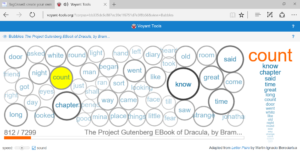The term is flying by. I just finished looking at students Emotion Maps from Week 3. They were amazing–I loved how diverse students’ choice of emotions were–from “anticipation” to “dominance” to “joy.” This assignment met my expectations for introducing students to the Library of Congress Chronicling America database collection while also introducing them to the steps for producing an annotated map as a collection that tells a story.
This week is mid-term, and I am introducing students to Franco Moretti and “distant reading.” It’s difficult to assume that all students will be able to wade through “The Slaughterhouse of Literature” and “Conjectures on World Literature.” Some of my students seem like they may be literature majors in the making, while others are unlikely to have read many novels at all in college. So I took it upon myself to create a lecture with 25 slides to introduce students to Franco Moretti’s New Method of Reading ; it includes paraphrases and summaries of these two articles, walking students through Moretti’s concepts. If I were teaching f2f instead of online, this would be an extended lecture/discussion class session–perhaps the entire class session. For my online class, my goal is to give students the background for why we would want to use “distant reading tools,” and in the absence of a lecture setting, I simply told them what I thought Moretti was getting at I love the term “methodologically bold” that Moretti uses to inspire students everywhere to come up with hypotheses.
After students read both these two essays and my summaries of them, I ask them to follow Paul Fyfe and Ryan Cordell and “not read” a Victorian novel from Project Gutenberg. I had wanted to try multiple tools, but in the end I realized that Voyant alone is enough of a challenge, and so I created a step-by-step for students to work with Voyant and post their discoveries and “bold methodologies” to their blogs.
Here are my instructions with screencaptures, rubric and grading criteria. I have divided into two files because they are large files.
Instructions McGrail Distant Reading Part 1Instructions McGrail Distant Reading Part 1
Instructions McGrail Distant Reading Part 2Instructions McGrail Distant Reading Part 2

